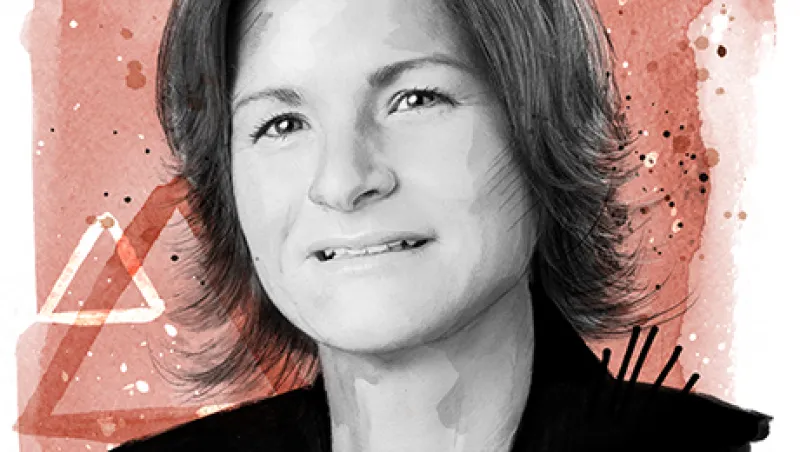Robin Diamonte never planned on a career in investment management. After graduating from vocational high school in New Haven, Connecticut, she took a job as an electrician on a nuclear submarine before deciding to pursue a college degree in engineering. In 1986 the newly minted engineer began a new career in telecommunications, ultimately landing a job as a computer technician at GTE Corp. (which would become Verizon Communications). It was there, in the early 1990s, after logging many hours configuring hardware and software and installing cables for research analysts and portfolio managers in the telco’s pension investing group, that Diamonte found her true calling.
“It was fun to fix things, but they weren’t meaningful problems,” she says. “Investing is all about solving a puzzle and winning: How can you use data to win? How do you get a competitive advantage?”
Twenty years later Diamonte, 50, is overseeing $53.8 billion in one of the biggest pools of private retirement assets in the U.S. As CIO of conglomerate United Technologies Corp. — which makes everything from Otis elevators to Black Hawk helicopters — Diamonte has demonstrated a fervent desire to provide bona fide pension benefits in the age of defined contributions and to become a national resource on retirement security issues. Hired by Hartford, Connecticut–based UTC at the end of 2004 to bring innovation and a fresh perspective to its investment office, she revamped and modernized the defined benefit pension portfolio with complex and sophisticated investment strategies. The CIO also brought a fresh focus to the company savings plan, adding features to make it as close as possible to a real pension benefit with guaranteed lifetime income.
The shock of seeing participants’ savings plan account balances drop by 30 percent in 2009 drove Diamonte to look for a way to boost the plan and provide a lifetime income strategy (LIS) to UTC workers at the same time the company was phasing out its long-standing traditional pension plan. Diamonte led a multiyear, multidepartmental effort, enlisting crucial buy-in from senior management that was essential to its success. Aided by Kevin Hanney, head of defined contribution and international investments, the nearly six-year effort included essential input from then-CFO Gregory Hayes, human resources executive Natalie Morris and in-house attorneys Richard Kaplan and Zachary Osborne. (Hayes was promoted to CEO of UTC on November 24 following the surprising resignation of Louis Chênevert, who had been chief executive for six years.)
“Robin came up with cutting-edge strategies in the time of no FAE,” says Hayes, referring to a commonly accepted pension plan calculation that is based on an employee’s final average earnings and provides a secure income flow in retirement. “It’s our responsibility to take care of employees to the extent that we can.”
Taking care of employees meant devising a way to create and run a multi-insurance-provider platform within a guaranteed minimum withdrawal benefit annuity scheme while keeping costs as low as possible. Another significant hurdle was convincing everyone from the seniormost executives to the savings plan participants that this was the best solution to ensure lifetime income. “The whole idea of this was Robin’s response to the board and [then-CEO] George David’s question, ‘How do you guarantee lifetime income?’” explains Hayes, who joined UTC in 1999, when it acquired aerospace and industrial products maker Sundstrand Corp., where he was CFO.
“When you have money in a defined benefit context, it’s wholly different from individual assets,” stresses Hanney, who was hired by Diamonte in 2005. “There’s longevity mortality pooling, a viable source of funding in case of shortfall and insurance for loss of funding,” he adds, referring to the insurance provided by the Pension Benefit Guaranty Corp., the federal agency established by the Employee Retirement Income Security Act of 1974, which governs private pensions. “These are areas we simply can’t meet here. In the absence of other means, insurance is the way to go.”
Diamonte introduced liability-driven investing to match the pension assets to their future liabilities. She hired hedge fund managers for a portable-alpha strategy and added a risk parity strategy. The results of the portfolio redesign have been stellar. For the five years through June 30, 2014, the $25 billion U.S. defined benefit fund has returned 15.2 percent, compared with 12.8 percent, gross of fees, for the median large pension fund, according to data from Mellon Analytical Services’ corporate plan universe. Last year the fund produced 8.7 percent, versus 6.8 percent for the Mellon universe.
Diamonte “doesn’t rely as much on what she knows as what she doesn’t know,” says Robert Prince, co-CIO of Westport, Connecticut–based Bridgewater Associates, the world’s largest hedge fund firm. Prince has managed assets under Diamonte’s purview since 1996, when she was at Verizon, starting with Bridgewater’s All Weather fund, the first so-called risk parity strategy, designed to provide a positive return under any market condition by balancing risks. “She doesn’t feel she has to prove herself,” he continues. “It’s that open-mindedness and curiosity that has made her an innovator.”
The challenges of being a top investor might be enough for some pension officials, but not for UTC’s CIO. In her first decade at Verizon, when Diamonte rose from research analyst to managing director, it was all about winning the investment game. By the time she arrived at UTC, the game was changing. “When I saw defined benefit plans were going away, I saw there was a real problem,” explains Diamonte. “I said, ‘This is bad, and we have to do something about it.’” In response, she began taking an active role in the national dialogue on how to improve retirement income security.
Today, Diamonte’s calendar is bursting with internal and external commitments meant to bolster employees’ retirement benefits. She chairs UTC’s defined contribution investment committee and is a voting member of its pension advisory investment committee. Outside the U.S., Diamonte is a trustee for seven different British pension trusts of various UTC subsidiaries and chair of one, requiring her to travel to the U.K. four weeks a year.
On a national level, Diamonte serves on the PBGC Advisory Committee, to which President Obama appointed her in December 2013, giving her a forum to express ideas for improving the private pension system in the U.S. She chairs pension executive affinity group CIEBA (the Committee on Investments of Employee Benefit Assets), where she confers with her counterparts at other large U.S. corporations, and receives invitations to speak to officials at the White House and Department of Labor.
“I got the bug,” Diamonte explains. “I want to be able to help these regulators understand the issues so we can make it better. They listen to us because we’re not in a business where we’ll make money from a solution.”
Diamonte is making more headway with regulators than with her own peer group. So far, she and Hanney have not been able to persuade other corporate pension sponsors to adopt their lifetime income solution. Although 10 percent of UTC employees have enrolled in the strategy since its June 2012 launch, not one other large corporate defined benefit plan has started offering the benefit. “We thought if we set the groundwork, other companies would follow suit,” Diamonte says ruefully.
ROBIN DIAMONTE WAS BORN IN 1964 to a working-class family in New Haven. Her mother worked as a toll collector for the state of Connecticut, and her father repaired seat upholstery, among other tasks, for railroad operator Amtrak. After graduating as valedictorian of her eighth-grade class, Diamonte chose to attend Eli Whitney Technical High School because of safety concerns in her rough public school neighborhood. Bored with most of the vocational program, she trained as an electrician and upon graduation in 1982 took a job on a naval submarine for Electric Boat in Groton, Connecticut. Her union supervisor advised her to get a degree, so Diamonte enrolled at the University of New Haven on a scholarship, the first member of her family to go to college.
In 1986, after graduating with a BS degree in electrical engineering, Diamonte snagged a job as a microwave radio engineer at Southern New England Telephone Co. (SNET), where she spent the next five years. “I hated it because it was a dying technology” as fiber-optic communication was emerging, she says. After learning computer technology, in 1991 she leveraged the SNET job into a help-desk post for the thornier issues at GTE’s Stamford headquarters.
The stage for her investment career was set when a position for a dedicated IT worker opened up in GTE Investment Management Co., the pension investing office. “I was under the desks of the portfolio managers” hooking up computer cables, says Diamonte, who by 1992 had completed an MBA in finance at her alma mater at night.
T. Britton (Britt) Harris IV, then president of GTE’s pension investment group and now CIO at the Teacher Retirement System of Texas, recalls: “Hiring Robin Diamonte was one of the best decisions of my corporate life. I had no idea what we were really getting when we brought her in to work in our information systems area. All I knew was that she had an engineering degree, had worked on submarines, had recently received her MBA and that someone said that she could solve our computer problems.”
Harris continues: “Frankly, the first time that I truly noticed her was when I received our annual [performance] ranking of all of our [40] employees. Historically, I had been ranked first. Now it was someone named Robin Diamonte. I felt a little like the queen who had just discovered that there was someone new in the kingdom that was more fair than she was.”
Diamonte was about to change her boss’s life. When a portfolio manager asked the computer technician to help him write an asset management program, she was hooked. “Because I had to write that program, I had to learn about investing,” she recalls. The next thing Harris knew, his IT worker was asking for an investment analyst role. “I asked Robin to move to our research area, where, frankly, we were struggling at the time,” he says. “Then, within the year, I asked Robin to take over.”
By 1997, Diamonte was director of research. In 1999 she was promoted to managing director in charge of research, internal and external asset managers and the strategic partnerships conceived by Harris and his predecessor, John Carroll. In these partnerships four firms — Goldman Sachs Asset Management, GMO, J.P. Morgan Asset Management and Morgan Stanley Investment Management — were given large mandates to invest any way they chose. “She came at a transitional stage, when we were taking more equity in-house and putting together quantitative models to manage it,” recalls Carroll, who retired in 2000, just after GTE merged with Bell Atlantic Corp. to become Verizon and the pension fund peaked at $80 billion. “Because she was always looking for more, she was given more, mostly due to Britt.”
The GTE investment office survived the merger because its fund performance had been better than that of Bell Atlantic’s pension office. Diamonte was content in the No. 2 role at Verizon Investment Management Corp. when she received a phone call from a search firm in early 2004. United Technologies’ ten-year CIO, Harsh Bansal, had defected to rival Honeywell International in Morristown, New Jersey, and the company was looking for a replacement.
During her first interview Diamonte was not impressed with the UTC job, and the company did not seem to be impressed with her. “I was not in sync with senior leadership,” she says. “Their message was, ‘This is the way we do things.’ I gave them my answers, but I knew that’s not what they wanted to hear.” Another impediment was that Diamonte had just become a new parent. Her partner, Lori Iannucci, a master’s-level social worker, had given birth to their first baby girl, and Diamonte was hesitant to take a new job and relocate to the Hartford area. “I wasn’t that disappointed because I loved working with Britt,” she adds.
By August, however, the zeitgeist had changed at UTC, particularly with the addition of new co-CFOs: Hayes and James Geisler, who had served as UTC’s vice president of strategy for business development and acquisitions during his 17-year career there. Diamonte was called back for a second meeting that was very different from the first. The pension investment committee had turned over, with Geisler as the new chairman and Hayes as a member. Legal counsel was close to retirement. This time senior executives spoke about the change, diversification and innovation they wanted to bring to the defined benefit fund, which was made up of 85 percent public equities. With more latitude to bring change to UTC, Diamonte accepted the position. (Geisler left in 2010 to become COO and CFO at Creosalus, a Kentucky-based life-science company.)
It was very hard to leave Verizon and its then-$35.5 billion fund, Diamonte says. She had been fortunate to spend a decade working with a very close-knit group that had little turnover. Now it was her turn to bring that culture to her new team at UTC.
THE STORY OF UNITED TECHNOLOGIES IS A CLASSIC TALE of a U.S. conglomerate’s growth by acquisition, followed by consolidation. It began in 1929 with an aircraft business and grew through numerous mergers and purchases starting in the late ’70s. The company, which took its current name in 1975, now comprises six business units that provide high-tech products and services to the global building systems and aerospace industries. Familiar industrial names like Carrier Corp., Otis Elevator Co., Pratt & Whitney and Sikorsky Aircraft Corp. are all part of the UTC family.
UTC’s traditional pension plan was first offered in the late 1940s or early ’50s — too long ago for an exact record to exist. The FAE pension benefit formula was introduced in 1978, not long after Congress passed ERISA. UTC also began offering a 401(k) plan in 1978, the year the tax-advantaged savings vehicle was amended to ERISA law. UTC’s first savings plan had three options: a stable-value fund (still one of the most popular options), an S&P 500 index fund and company shares.
Like other large corporations dealt a blow during the post-dot-com-bubble market collapse from 2000 to 2002, UTC looked to the pension fund to reduce costs and balance-sheet volatility. It began offering a cash balance pension plan in 2003 instead of the traditional FAE plan. Then came the financial crisis of 2008–’09. Company earnings dropped by 16 percent, and the pension portfolio took a $7 billion hit from $17 billion at the end of 2007. UTC fell from a precrisis high of $81 a share to $37 at the market’s nadir, on March 9, 2009.
That same year the company took an $830 million restructuring charge, which resulted in the elimination of 25,000 jobs and a reduction in hours for 10,000 other employees in the 225,000-member workforce, saving UTC $1.5 billion over the next five years. “That sparked the thought that we needed to do something with the pension plan too,” Hayes explains. “It’s all driven by the macro economy.”
UTC closed its pension plan to new employees in 2003, as many other U.S. corporations have done, offering them instead the hybrid defined benefit cash balance plan. (Hayes says moving out of the traditional pension into a cash balance plan, which was closed to new employees in 2010, has saved the company $600 million over the past five years.) Diamonte might have followed the same path as her peers and fallen back on the company 401(k) plan as the default retirement vehicle, but that did not suit the new CIO, who wanted to provide employees with something closer to a real pension. To get there, she enhanced the company savings plan options and formed an executive group to build the auto-enrollment lifetime income strategy.
After the cash balance plan was closed, Diamonte and Hanney intensified their effort to improve the savings plan. They changed the investment lineup from 20 individual core fund options to nine passively managed ones with, at 7 basis points, the lowest possible fees. They offered an S&P index fund with a fee of less than 1 basis point and added customized target date funds. These are “the best and cheapest funds in corporate America,” Diamonte boasts. New employees are defaulted into the savings plan with a contribution rate of 6 percent of salary that auto-escalates each year until it reaches 10 percent.
Next came the June 2012 launch of the lifetime income strategy, which had been six years in the making. The strategy encompasses the key elements of a guaranteed lifetime withdrawal benefit, including professionally managed investments and a guaranteed floor income benefit with upside potential, liquidity (participants are allowed to withdraw funds) and joint life and beneficiary features (unlike a single annuity, the UTC plan allows beneficiaries to inherit the remaining assets when the plan participant dies).
The underlying investment funds in the LIS are essentially the same as the nine target date funds in UTC’s traditional savings plan lineup. The program is designed by AllianceBernstein so that when participants reach age 48, their assets begin a glide path, or phase-in, of the secure income annuitized portfolio, making incremental annuity purchases that end at age 60, when the portfolio is fully guaranteed.
When Diamonte took the helm of the investment office in December 2004, she was the fourth woman to oversee retirement assets for UTC, starting with Beverly Hamilton in the mid-1980s. (Hamilton went on to a successful career in asset management and now serves on numerous investment company boards, as well as the investment committees of the Rockefeller Foundation and her alma mater, the University of Michigan.) Frances Hawk succeeded Hamilton as assistant treasurer, pensions and benefit management, in the early ’90s and was soon followed by director of investments Cynthia Steer — now head of manager research and investment solutions at Bank of New York Mellon Corp. — who held the position from 1992 to 1995. Bansal broke that mold, serving as CIO from 1995 until his departure for Honeywell in 2004.
Diamonte arrived to face a very different environment from the one she experienced during her 13 years at GTE and later Verizon. The UTC investment office had suffered several key executive departures and had just four staffers, including an assistant, in stark contrast to the 40 or so she’d left at Verizon, which had a similar-sized portfolio. In addition, the CIO role at UTC historically had been much more integrated with accounting, control and company finance than at Verizon, where the investment office had functioned with greater independence. “We only thought about maximizing investment returns and minimizing risk,” Diamonte recalls. Investment returns at UTC are viewed in light of total company performance.
One of Diamonte’s first tasks was to diversify the portfolio. In December 2005 she launched the portable-alpha strategy, in which hedge fund returns — the alpha — were transported to the market returns, or beta, of a plain-vanilla fixed-income or equity portfolio (see “A Complex Hedge Fund Strategy Works for United Technologies”). Diamonte tapped Bridgewater in March 2006 to run the risk parity strategy. Julie Glynn, whom Diamonte hired as investment director in 2007 to oversee global equity, risk parity and absolute-return strategies, recalls the reaction to these new investments. “Nobody liked to use the words ‘hedge fund,’” says Glynn, who previously had run performance attribution at Aetna’s investment management division. Bridgewater’s Prince and Pacific Alternative Asset Management Co. CEO Jane Buchan, who now runs a fund-of-one for UTC, were brought in to explain their investment philosophies to UTC’s pension committee. “The committee was blown away with how bright these people are,” Glynn says.
Diamonte’s first staff hire in 2005 was Hanney, a former analyst with the 1199 Service Employees International Union health care workers’ pension fund in New York. His initial role was to oversee $4.5 billion in U.K. pension assets that ultimately included the acquisitions of Kidde, Chubb Security and Goodrich Corp. British pensions, which are governed by independent, career trustees, take an adversarial position with companies, making plan sponsorship a challenge.
Next, in a somewhat unusual move, Diamonte hired Charles Van Vleet, a former credit analyst and portfolio manager at Credit Suisse. After the passage of the Pension Protection Act of 2006, Diamonte saw that she would need a bond specialist to oversee the liability-driven-investing strategy, says Van Vleet, who in February 2013 took the CIO and assistant treasurer role at Providence, Rhode Island–based Textron’s $10 billion pension fund. Today the UTC investment office has eight professionals, including Diamonte.
IN EARLY SEPTEMBER, Robin Diamonte flew to Washington. For much of the past decade, the UTC CIO has been summoned to the nation’s capital to brief federal officials on ways to improve retirement income security benefits. The September meeting was scheduled with members of the White House administration and the U.S. Department of Labor.
Soon after landing Diamonte joined several other pension industry executives at a local Starbucks to strategize before the 60-minute meeting. They wanted to prepare for an audience that would include members of the National Economic Council, the Domestic Policy Council and the Council of Economic Advisers. Their testimony would inform impending law- and rule-making decisions necessary to ensuring the financial future of the U.S. workforce.
Once at the meeting Diamonte expressed her frustration with the persistent 401(k) rollover coercion plaguing UTC’s retirement savings plan participants. “Fidelity and Vanguard call up our retirees to get them to roll their 401(k) plans into their mutual funds or when a plant closes,” she explains. “They don’t tell them that their fees will double and triple. They don’t have to tell them that.” Diamonte has been an ally in the DoL’s years-long battle to eliminate the conflict of interest between aggressive fund sales and genuine advice (see “Mary Jo White and the Investment Adviser Regulation Debate”).
“People who aren’t subject to the ERISA fiduciary standard of care have a much lower standard of care,” agrees Hanney, who currently serves as a member of the DoL’s ERISA Advisory Council.
Since the June 2012 launch of the lifetime income strategy, the pressure on Diamonte, Hanney, Hayes and human resources executive Morris to ensure that UTC employees have a bona fide retirement vehicle has not let up. The last defined benefit pension plan at the company is poised to sunset at the end of 2014; all participants in the old plan will cease to accrue benefits. Employees hired before July 2002 will see their assets moved to the hybrid cash balance plan.
As director of employee benefits, Morris knows how difficult it is to persuade people to manage their own retirement savings. Much of her time has been spent trying to educate UTC employees about their choices. The question facing her, as well as her counterparts at other U.S. corporations and, for that matter, the DoL: Is there a way to ensure that the U.S. workforce has sufficient assets to retire with comfort, or at least with dignity?
“I’m not sure we can, but we’ll continue to try to crack that nut,” Morris says. For its part, UTC is using findings from behavioral finance to perform segmentation analysis based on employees’ preferences and help the company’s 200,000-plus workers make more-informed decisions. “We’re getting more scientific,” she explains.
Still, there’s no substitute for hands-on contact, Morris notes. In automating HR functions, she says, “something has been lost.” She is looking to get UTC’s human resources generalists more involved in engaging employees with their benefits, especially the 110,000 participants in the savings plan. “We really want to offer something that replicates a pension for employees,” she says.
Diamonte, who was promoted from director of pension investments to CIO in 2013, is disappointed that other large companies have not followed UTC’s lead. She has spent countless hours extolling the benefits of the LIS to her peers, and Hanney and Morris have been on the conference trail doing the same. There has been a lot of debate in the plan sponsor community about whether employees will choose a LIS if given the option.
Diamonte’s frustration is palpable. “We spend a lot of time with people wanting to benchmark us,” she says. “Kevin has taken a lot of time speaking at conferences, taking calls, doing webinars, trying to get people engaged. You get to the point where people are really excited about it but nobody does anything about it.”
“The reason [lifetime income strategies] aren’t adopted more readily is because we’re too focused on the risks of adopting them and not giving enough weight to the risks of not giving them,” says Martha Tejera, a former enrolled actuary at Mercer and Wyatt Co. and retirement plan adviser with the Institutional Retirement Income Council. Tejera, a consultant with her own, eponymous firm, based in Bainbridge Island, Washington, believes “it’s incredibly naive” to think employees can manage their 401(k) lump sums to sustain them over decades of retirement. “Part of the magic of what UTC is doing is they’re making it the cornerstone” of their retirement offering, she adds.
Other observers offer reasons for the slow acceptance of LIS in defined contribution plans. “The plaintiffs’ bar seems to have had a chilling effect on things like lifetime income,” says UTC counsel Osborne. “I don’t think many companies are willing to take the time and money that UTC has,” he continues. Company executives ask: “What’s in it for us? Are we just going to get sued?”
Another reason: There hasn’t been much innovation since the Great Recession given all the staff cuts, points out Richard Shea, an ERISA attorney with Covington & Burling in Washington. “They’re getting done what needs to be done and not a lot more.”
Former UTC investment officer Van Vleet is one of 19,600 people in the lifetime income strategy. “I stayed in it,” he says. “It’s terrific mortality insurance. I spent 25 years on Wall Street with no pension.” Van Vleet had been looking to buy a deferred annuity when the LIS was launched. He found the strategy’s 1.2 percent fee much more favorable than the 3 to 4 percent annual cost of a single annuity. Despite his own enthusiasm for the strategy, Van Vleet is not surprised that the LIS isn’t receiving take-up. “It’s too complex,” he explains, and most CEOs and CFOs, and his new employer, are too busy “to embrace the idea that we’ve lost a workforce tool.” Also, he says, many companies are concerned that they don’t have a strong enough safe harbor from the DoL.
Jeffrey Brown, a finance professor at the University of Illinois at Urbana-Champaign, demurs. “We all need to remember why we have these plans in the first place,” he says. “It’s not to provide people with a lump sum of wealth at a certain age. It’s to provide people with retirement security.”
His conclusion: “We may as well get out in front of this and learn along the way. It’s pretty clear we’re going to get there. It could be in the next three or ten years. Policymakers recognize this fact.” Brown’s point was given a boost on October 24, when the U.S. Treasury Department and the Internal Revenue Service issued guidance designed to expand the use of annuities in 401(k) plans, including default target date fund investment options used as a qualified default investment alternative.
At UTC the LIS has been gaining more widespread favor among employees still in the traditional or hybrid pensions. The first year the company began auto-enrolling new hires, 80 percent of investors were auto-enrollees; 20 percent chose it for some or all of their savings plan. In the year ended June 30, 2014, however, the trend shifted: Close to 60 percent of participants actively selected the annuitized option for some or all of their savings plan assets.
This is just the beginning of UTC’s efforts to bring pensionlike benefits to employees. “We’re responsible for designing choices,” Hanney says. “This is our best attempt. We’ll continue to improve it. We’ll make changes under the hood so 116,000 participants don’t have to relearn.”
In the meantime, Diamonte and Hanney will travel to spread the good word. In mid-October, Hanney went to London for a five-hour series of meetings with seven staffers at the U.K. government–sponsored National Employment Savings Trust auto-enrollment program, including senior people in its investment, engagement and administration groups. In their search to enhance their 1.6 million-member savings scheme with a lifetime income solution, NEST officials are looking at all available alternatives. The discussion centered on the concept of “defined ambition,” a hybrid pension model that attempts to capture the best features of defined benefit, defined contribution and UTC’s approach to lifetime income. NEST and UTC’s strategy “may not precisely be twins, but certainly no less than close cousins from across the pond,” explains Hanney, who plans to submit material for use as a case study in a discussion paper NEST will publish soon. “We’ll be watching what they do very carefully for our own plans in the U.K.,” he adds.
For her part, Diamonte was back on a flight to Washington in late October. First up was a regular scheduled PBGC meeting, followed by a CIEBA meeting. Then it was on to a roundtable discussion with U.S. Labor Secretary Thomas Perez on how impact investing fits with ERISA. In a fourth meeting, at the Retirement Clearinghouse, Diamonte once again shared her expertise on public policy challenges by arguing for the benefits of improving portability — trying to make it easier for people to roll in other assets to their 401(k) plans — within the U.S. retirement system.
Diamonte’s efforts could get a boost from the recent elevation of Hayes to CEO. “Greg is the guy,” says Cowen Group analyst Cai von Rumohr. “He understands the pension more than the vast majority of CEOS because he’s been a very strong CFO.” • •
Get more on pensions. Follow Frances Denmark on Twitter at @francesdenmark.






